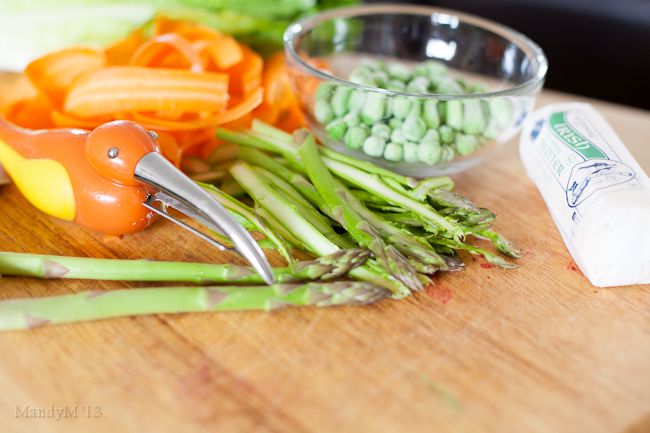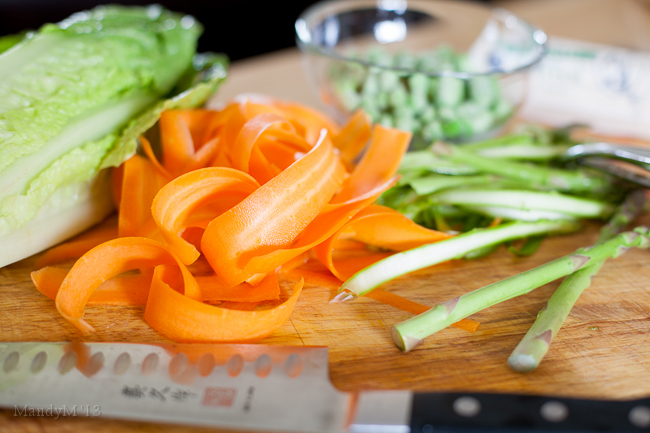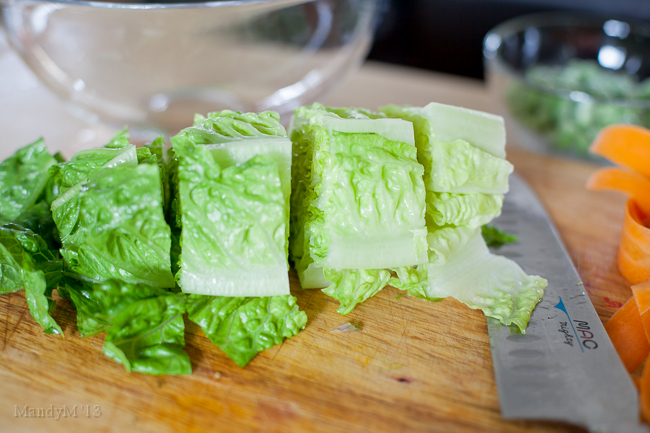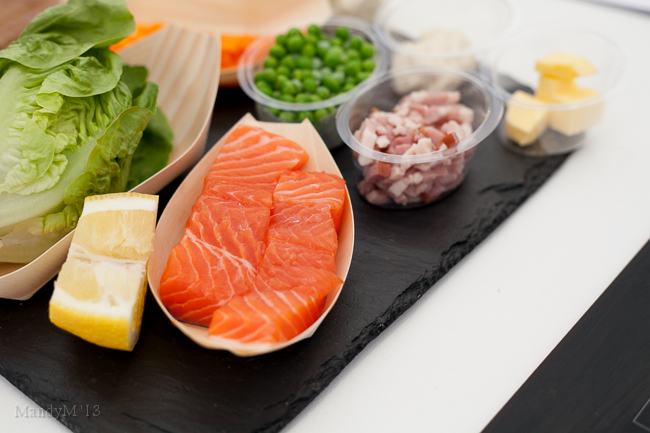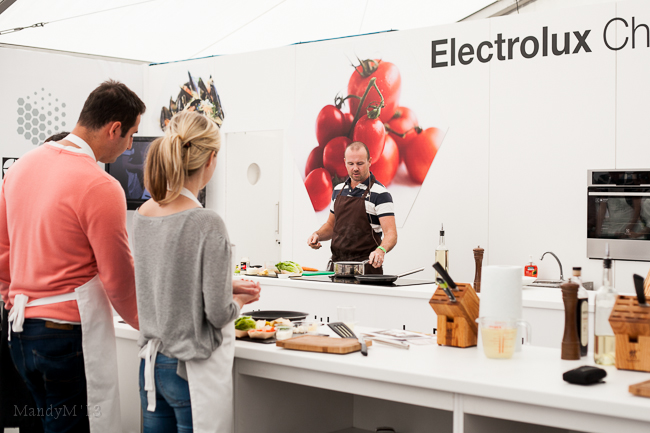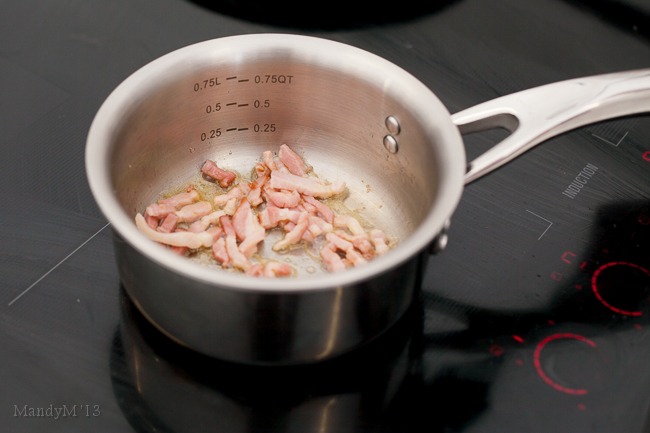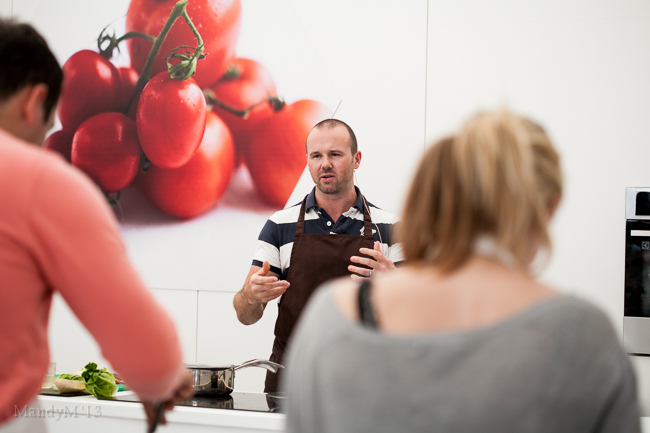I mentioned in my I Like... Taste of Dublin post that I'd taken part in one of the cooking lessons with Michelin star chef Oliver Dunne in the Electrolux Chefs' Secrets tent.
I didn't know what we would be cooking until the lesson actually began, and I won't lie, I was a little disappointed to find out that it was a fish dish.
You see, I'll eat every other kind of seafood, but somehow fish doesn't excite me.
But, I wanted to enjoy the experience of having a lesson with such an amazing chef, also, we'd be getting to use an induction stove. If you've never used one before, carry on reading and I'll tell you why they're so friggin' cool!
Left: Sasha, my partner in cooking crime that day at the Taste of Dublin
Right: Our ingredients for the cooking lesson in the Electrolux Chefs' Secrets tent
During the lesson, Oliver Dunne dropped all sorts of hints and tips, most of which I've tried to remember and put into practice in my every day cooking. And seeing as the food community is all about sharing, I thought I'd share some of those tips as well as the recipe that he taught us.
But why would I share a recipe with an ingredient I'm not entirely crazy about? As it turns out, it was damned delicious!
A small disclaimer before I get into all the tips and tricks and everything else.
When we made this dish at the Taste of Dublin we had used Sea Trout fillets. But when I decided to give this a go at home I thought I would try it with Salmon, as it's something you can pick up in your local supermarket on a whim.
The flavours of the veggies and sauce went very well with the Salmon, but I preferred the actual flavour of the Sea Trout. In my opinion, it is definitely well worth a trip to your fishmonger to buy fresh Sea Trout fillets for this dish.
W
A little bit of seasoning
I mentioned that we got a chance to use induction stoves in the Chefs' Secrets tent and that they're pretty darn awesome. I won't go into all the technical stuff behind it (to be honest, I think it's more magic than anything else ;) ) but basically, the cool thing about induction stoves is that it only creates heat when the pan is in contact with the stove plate. That is, there's no element sitting under the glass top constantly on and giving off heat. I'm telling you, it's the coolest thing. Pan on. SIZZLE! Pan off. Hello? Is this thing on?
It's like gas in the way that once you turn it off, the heat source stops in the pan. But what I particularly like about it, is that as soon as the pan is off the stove, the hob isn't radiating heat, and once you turn the stove plate off, the glass is cool in seconds (maybe not seconds, I didn't exactly put my hand flat on the thing to test it ;) ) and that's awesome because when it comes to cooking in Summer, the last thing you want is your stove acting like a room heater! (My hubby's obsessed with thermometers and we have one in the living area. I'm always amazed at how the stove or oven bumps up the room temperature by a degree or more!)
Two of the guest chefs who did a masterclass at the Taste of Dublin actually mentioned that they'd replaced all the stoves in their restaurant (gas, I'm assuming) with induction stoves to help keep the heat down in their kitchen, and it worked.
The Electrolux induction stove in action
My own normal stove doing fine, but nowhere near as awesome as induction
Now, this wasn't the first time I'd used an induction stove. They had a different brand at one of the cooking schools I went to for a chocolate making course (I won't mention the brand 'cause I wasn't particularly impressed with them.) And I tell ya, that brand was a right pain to use!
For whatever reason, when you lifted the pot or pan off the induction top, even slightly, the stove would turn off completely and reset, so when you put the pan back down on the surface, you had to turn the stove back on and reset it to the heat you were using. I know that the whole point of an induction stove is that the pan or pot needs to stay in contact with the surface for it to carry on cooking so as soon as you lift it off, the heat stops, BUT, every now and then, you might want to give everything in your pan a toss to mix things around (I've perfected the cheffie pan toss thing, very show-off of me!).
However, the Electrolux induction hob we were using in the cooking lesson was far more logical than that! Lift pan off, no more heat and cooking. Pan back on, boom, instant heat at the setting you left it.
The Electrolux model also had a nifty instant heat setting, kinda like a quick nuke to get your pan hot within seconds. Turn off the boost button and you're cooking up a storm! I'm in love! (Maybe I should start saving up for an upgrade ;) Actually, I've seriously got my eye on one of their double ovens. Heck, while I'm at it, should go for the whole shebang. Wonder if I can talk hubby into a kitchen upgrade for my birthday!)
Cooked just right thanks to chef Oliver Dunne's instructions
The recipe itself is quite interesting, I'd never had anything like it before.
The star of the show is the fish, obviously. Skin cooked until crispy, then a bit of heat on all other sides to cook the fillet through just enough so that it's still moist and tender, finished off with a lemon butter glaze.
What the fish is served with is what I found so different (and delicious!)
Smoked bacon cooked until lovely and crispy in a bit of butter (bacon and fish? It works, trust me), then you add julienne carrots and sweet frozen peas, cook until just tender with the bacon in just enough chicken stock to almost cover your peas. By the time they're cooked, the stock has reduced slightly which becomes the base for the sauce. A few dollops of crème fraîche to make it creamy, and a teaspoon of horseradish to add a bit of heat. YUM!
At the very end just before you're ready to dish up with the heat turned off, toss in some sweet baby gem lettuce and get the leaves coated. The lettuce isn't actually cooked, but it's heated just enough to blend with the rest of the meal but still keep its lovely crunch.
I'm telling you, this may have me eating more fish!
Me being me, I thought I'd add my own bit of "flair" to the dish.
Apart from changing the fish to Salmon, I also thought I'd try a different lettuce. I went with a fresh and crunchy Romaine lettuce instead, which worked just as well as the baby gem lettuce did, and because it has a stronger flavour, it suited the Salmon perfectly.
I also love fresh asparagus, it's one of my favourite vegetables, so I thought I'd throw some in for good measure. It was quite subtle as I decided to shave them into ribbons, but it added a lovely earthy and sweet flavour.
Apart from that, I kept all the other ingredients the same, I just decided not to julienne cut carrots, but to shave them into ribbons instead. You could do it either way, of course, but I liked the look of the ribbons.
So, about those nifty tips that Oliver Dunne parted with.
1. For crispy bacon bits, boil your bacon.
To remove water from your raw bacon bits, boil them, drain them, then fry them. As he explained it, it's like when you've had a bath and you end up with raisin fingers. The hot water actually draws out moisture from the bacon. So less moisture means you'll end up with crispy bacon in no time.
2. Don't heat your oil with the pan.
When using stainless steel, iron or copper pans, don't pour your oil into the pan before it's actually heated up. When you do this, it changes the taste of the oil, even burning it. Put your pan on a stove turned up high, then once it's hot (hold your hand about an inch or two from the pan and you'll feel the heat) pour your oil in and start cooking. The oil will heat enough in just a few seconds.
(Now, the exception to the rule is when you're using non-stick pans, you do need to heat the pan with oil in it, because non-stick cookware releases fumes if the pan's dry.)
Oh, and incidentally, chef Oliver never cooks with olive oil, he prefers using canola or rapeseed oil.
3. When frying with butter, use oil as well
Most people know this tip, but if you're new to cooking you'll find this useful. Butter burns very quickly, especially when cooking with very high heats. So to avoid burnt butter, add a slug of oil as well. This way you get that lovely buttery flavour and the oil helps keep it from burning.
4. Fish in the pan
Your pan is hot, your oil is hotter, the last thing you want is to be splashed with that liquid lava when you put your fish fillets in the pan. Or any meat. So to avoid being splashed, hold the meat on the end furthest from you, and when you put it in the pan, dangle the free end at the edge of the pan closest to you, and lay the meat down going towards the back. So when you let the end bit drop in, the oil will splash towards the back of the stove. I hope that made sense!
5. Lemon, but not too much lemon
In this recipe, you finish off the fish fillet with a bit of lemon and butter. Chef Oliver doesn't squeeze the lemon juice directly onto the fish as you then get a very sharp and lemony fillet. Instead, melt a knob of butter in the pan, squeeze the lemon juice into the butter, and then simply spoon the lemony butter over the fish. This glazes the fillets so that they're gorgeously juicy, and adds a hint of lemon.
Light and fresh, this dish is perfect for a summer meal. So enjoy! (And remember, try the sea trout ;) )
Ingredients
Serves 2, easily doubled to serve 4 or more
2 Sea Trout or Salmon Fillets
2 thick cut or 3 regular cut Smoked Bacon Rashers, cut into bits
1/2 cup Chicken Stock
1/3 cup Frozen Peas
1 Carrot, cut into ribbons with a vegetable peeler
4 young Asparagus Stalks, cut into ribbons
2 Tbsp Crème Fraîche
1-2 tsp Horseradish (depending on preferred heat)
1 Baby Gem or Romaine Lettuce Head, outside leaves discarded
Oil for frying
Butter for frying
Salt and Pepper
1/4 Fresh Lemon
Method
- Heat a medium sized pot on medium high
- When hot, pour in a splash of oil (about a Tbsp) and add about 2 tsp butter
- Cook bacon pieces until crispy
- While bacon is cooking, heat a pan large enough to fit fillets on high
- Once hot, pour in about 2 Tbsp of oil
- Season fish fillets with salt and place skin side down in the pan
- Reduce heat to medium high and cook for about 4 minutes until the skin becomes crispy but not burnt
- Cook the fillets for 1 - 2 mins on all other sides, until the fish is just cooked through
- While fish is cooking, reduce pot's heat to medium
- Add the frozen peas to the bacon and pour in just enough chicken stock to almost cover the peas
- Cook for about 2mins, stirring occasionally
- Add the carrot and asparagus ribbons and cook for about 1 - 2 mins
- Reduce heat to low and stir in crème fraîche and horseradish
- Taste to check seasoning, add some freshly ground black pepper, and any salt if it needs it
- Turn off heat but keep pot on the warm stove plate
- Cut lettuce into strips and loosen. Discard the heart if it's hard
- When fish is ready, melt about 1 Tbsp of butter in the pan with the fish
- Squeeze lemon juice into the melted butter
- Spoon the lemon butter over each fish fillet and take pan off heat
- Lightly toss lettuce with the vegetables to coat the leaves with the sauce
- Plate your dish with the lettuce and sauce making a bed for each fillet
- Serve with crusty bread and a wedge of lemon
Dig in!









